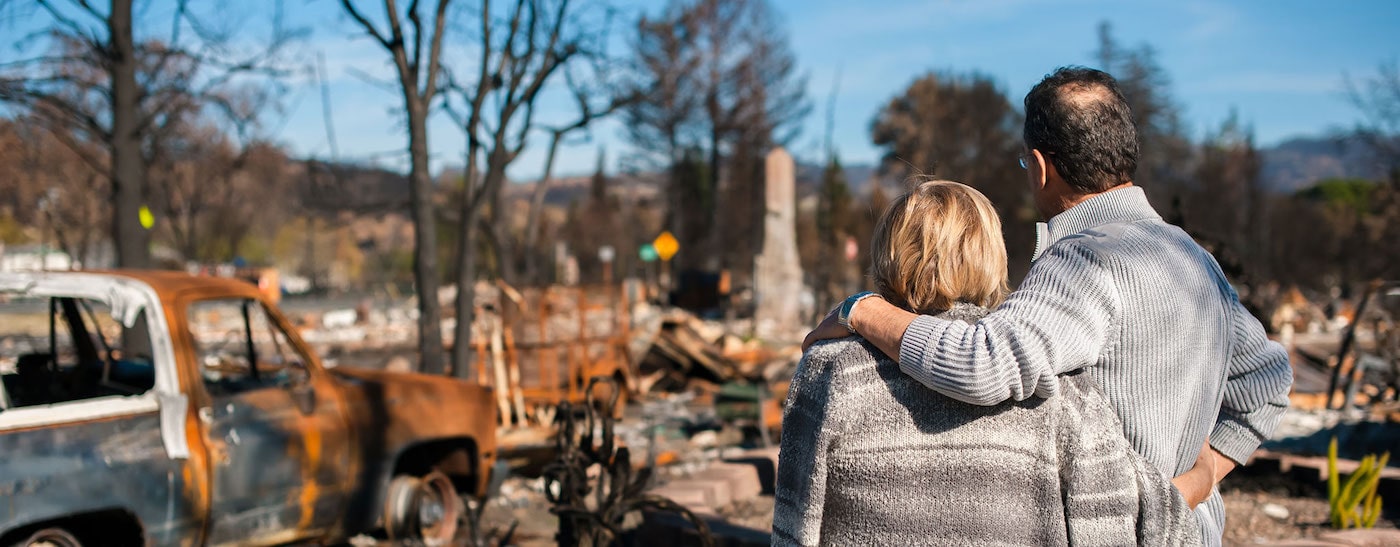Natural disasters, such as hurricanes and earthquakes, cause billions of dollars in damage in globally each year. According to a report from Aon, natural disasters cost the global economy $32 billion, of which only $14 billion was insured, in the first quarter of 2022 alone. Whether you or a loved one has been impacted by a natural disaster, you’re familiar with the devastating financial and emotional toll they can have.
From hurricane safety to protecting your property from wildfires, we’ve compiled an emergency preparedness guide with everything a landlord needs to know before and after a natural disaster strikes. We’ve also explained how landlord insurance can protect both your investment property and your peace of mind below.
Are you protected by the right insurance?
Different than homeowner’s insurance, landlord insurance is specifically designed for you. It protects against property damage for your building and helps with claims related to invasion of privacy or wrongful eviction.
Before Disaster Strikes: The Importance of Landlord Insurance
The best time to insure your property was yesterday; the second best time is today. Don’t wait until disaster strikes to evaluate your options — by then, it’ll be too late.
Your rental properties are best protected when you enroll in a comprehensive landlord insurance policy. Exactly what it sounds like, landlord insurance offers three key protections:
- Property damage, such as that caused by a natural disaster
- Loss of rental income/rental income protection
- Liability
Ready to learn more about disaster preparedness to further keep yourself, your tenants, and your property safe? Jump to:
- Hurricanes
- Wildfires
- Winter storms
- Landslides
- Earthquakes
- Handling an Evacuation With a Pet
- What to Do After a Disaster
- Helpful Resources
- Emergency Preparedness Checklist
Common Natural Disasters + Preparation Tips
While some natural disasters can strike suddenly with little to no warning, such as an earthquake, other disasters are predicted well before their arrival. In the case of hurricanes, for example, modern technology and science typically empower residents to prepare before the storm hits.
If you own a rental property in the path of a natural disaster, take note of the following disaster-specific instructions and preparation tips.
Hurricanes
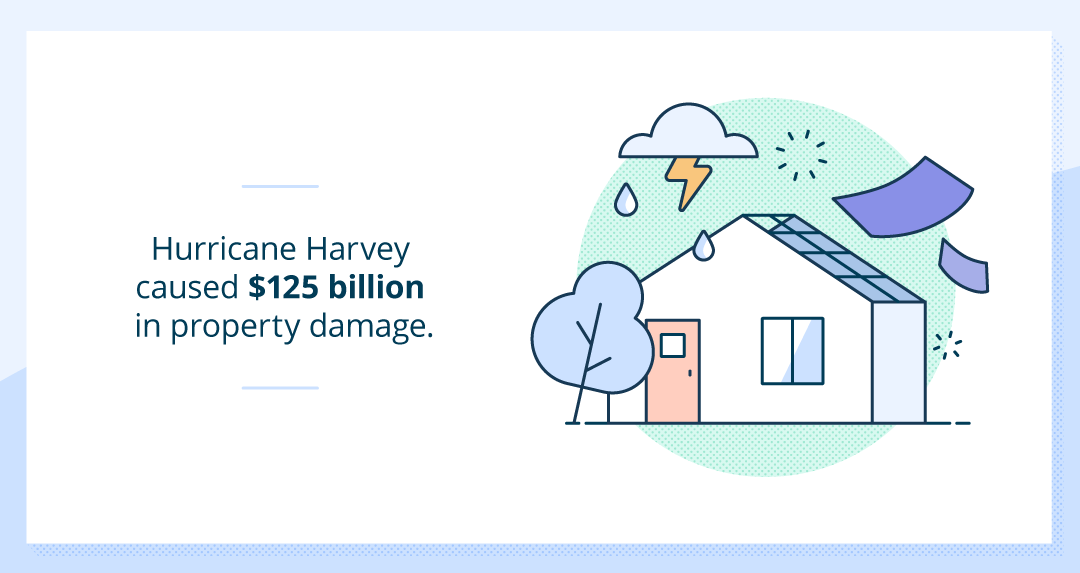
Hurricanes, also known as tropical cyclones, are powerful storms that affect a large portion of the United States and can cause massive damage to properties and communities. According to the National Hurricane Center, Hurricane Harvey caused approximately $125 billion in damages in 2017, making it the second most expensive hurricane to hit the mainland U.S. since 1900. (2005’s Hurricane Katrina takes the top spot, causing $170 billion in damages.)
These natural disasters can last from a couple of days to weeks at a time. On average, hurricane season starts June 1 and lasts until November 30, but that timeframe varies for each region of the country.
Regions most affected:
- Eastern Pacific Hurricane Season: May 15 through November 30
- Central Pacific Hurricane Season: June 1 through November 30
- Atlantic Hurricane Season: June 1 through November 30
The severity of hurricanes is indicated by a categorical wind scale, also known as the Saffir-Simpson Hurricane scale, which was developed by meteorologist Bob Simpson and wind engineer Herb Saffir. This scale has five categories and estimates different levels of property damage:
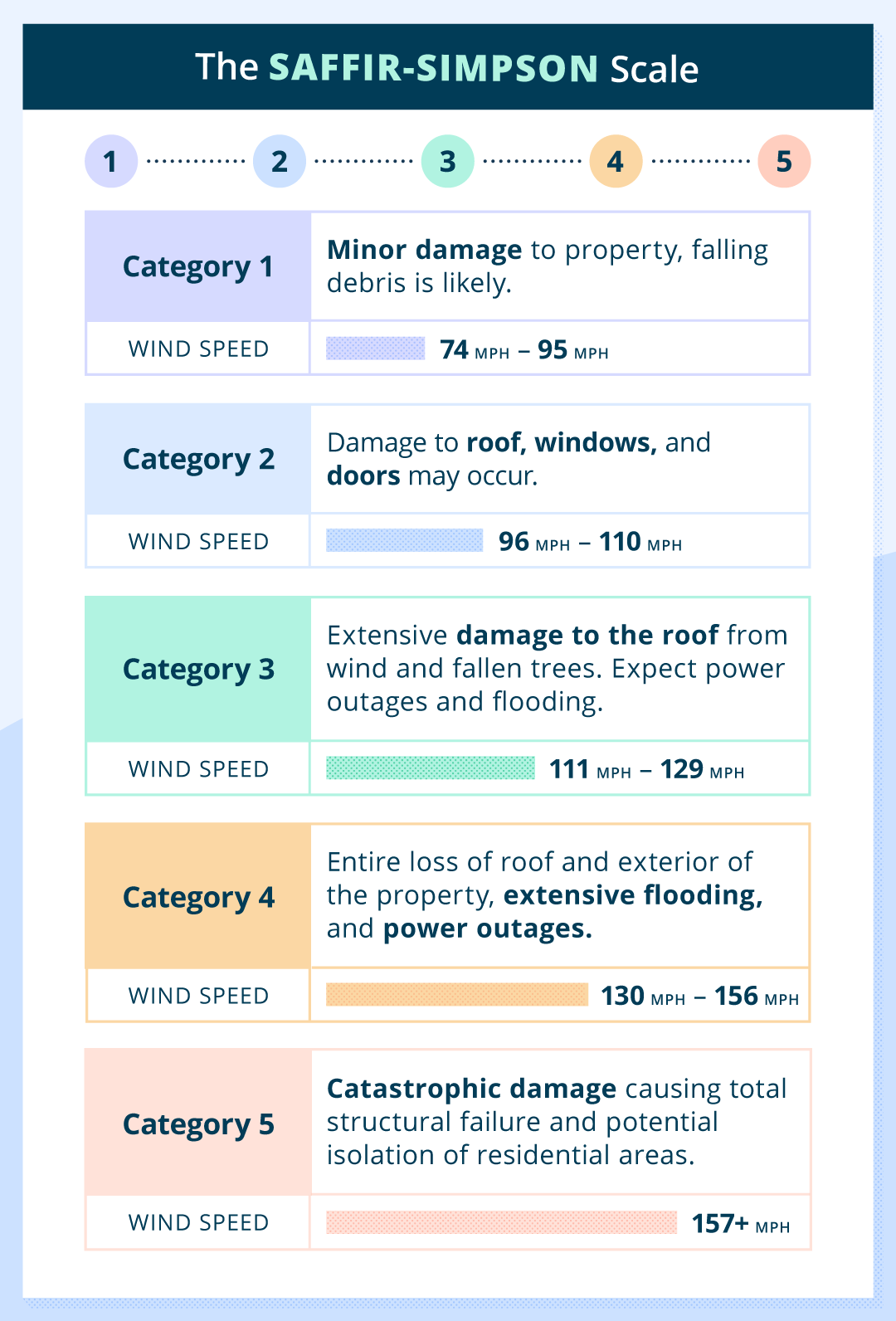
- Category 1: (Windspeed: 74–95 MPH) Dangerous winds could cause damage to homes with well-constructed frames, including the roof, shingles, and gutters. Small trees are likely to topple and branches will snap.
- Category 2: (Windspeed: 96–110 MPH) Major roof and siding damage, including windows and doors. Trees will be uprooted and can damage homes and block roads.
- Category 3: (Windspeed: 111–129 MPH) Devastating damage will occur to properties. Well-built homes will experience extensive roof damage from both wind and trees. Coastal homes are likely to flood. Utilities, such as electricity and water, will be unavailable.
- Category 4: (Windspeed: 130–156 MPH) Catastrophic damage will occur. Expect loss of most of the roof and some or all of the exterior walls. Extensive flooding may occur. Utilities and power outages will last from weeks to months. The area will mostly be uninhabitable.
- Category 5: (Windspeed: 157 MPH+) Total roof failure and collapsed walls. Complete power outages and isolation of residential areas may occur.
How to Prepare
As a landlord, there’s only so much you can do to prepare your tenants for a hurricane or tropical storm. While ultimately they must take responsibility for their own safety, you can provide them with instructions on how to best prepare themselves and their rental home. You can also provide the materials needed to protect a home during hurricanes if you own properties in a hurricane-prone area. Here are some tips to help you and your tenants stay safe:
- Plan ahead: Direct your tenants to the hurricane section of Ready.gov, which will help them prepare a family plan, evacuation plan, and safety plan.
- Clear debris: Be sure any damaged trees or old branches are trimmed on the property. Hire someone to remove all damaged limbs and trees, as these will quickly become dangerous during high winds.
- Make repairs: Make sure gutters and siding are secure. Repair any damaged components prior to the storm.
- Collect belongings: If your area is evacuating, encourage your tenants to prepare a disaster supply kit. This kit should have items that are able to last for up to three days, including non-perishable food, bottled water, cash, flashlights, battery chargers, and first-aid items along with any important documents and their I.D.s.
- Secure outdoor items: Ask tenants to secure any outdoor furniture or items that could be blown around. This includes patio sets, grills, children’s toys, etc.
- Acknowledge renters insurance: Let tenants know that if they have renters insurance, it is in their best interest to take photos of everything they own before they evacuate. This will make the process of filing claims much easier.
Hurricane Safety Tips
As a storm approaches, knowing what to do in the event of a hurricane is important in staying safe. If you have not evacuated from the area, here are a few safety tips for both landlords and tenants to follow:
- Stay inside and avoid windows that could shatter. Also, avoid the top floor of a property if applicable.
- Close the shades and blinds on all windows.
- Switch off appliances if the power goes out.
- Listen to updates from authorities and public safety officials.
Wildfires
Hurricanes are not the only natural disaster that causes destruction across the nation each year. According to the National Fire Protection Association, “major fires in the California wildland/urban interface (WUI) caused $4.2 billion in direct property damage in 2020 alone. Wildfires can happen anywhere at any time, spread quickly, and occur especially in areas that have consistent dry seasons. Unfortunately, humans can also contribute to these disasters.
Regions most affected:
- California (May through October)
- Texas (March through May)
- North Carolina (Mid-October through mid-December)
- Georgia (May through September)
How to Prepare
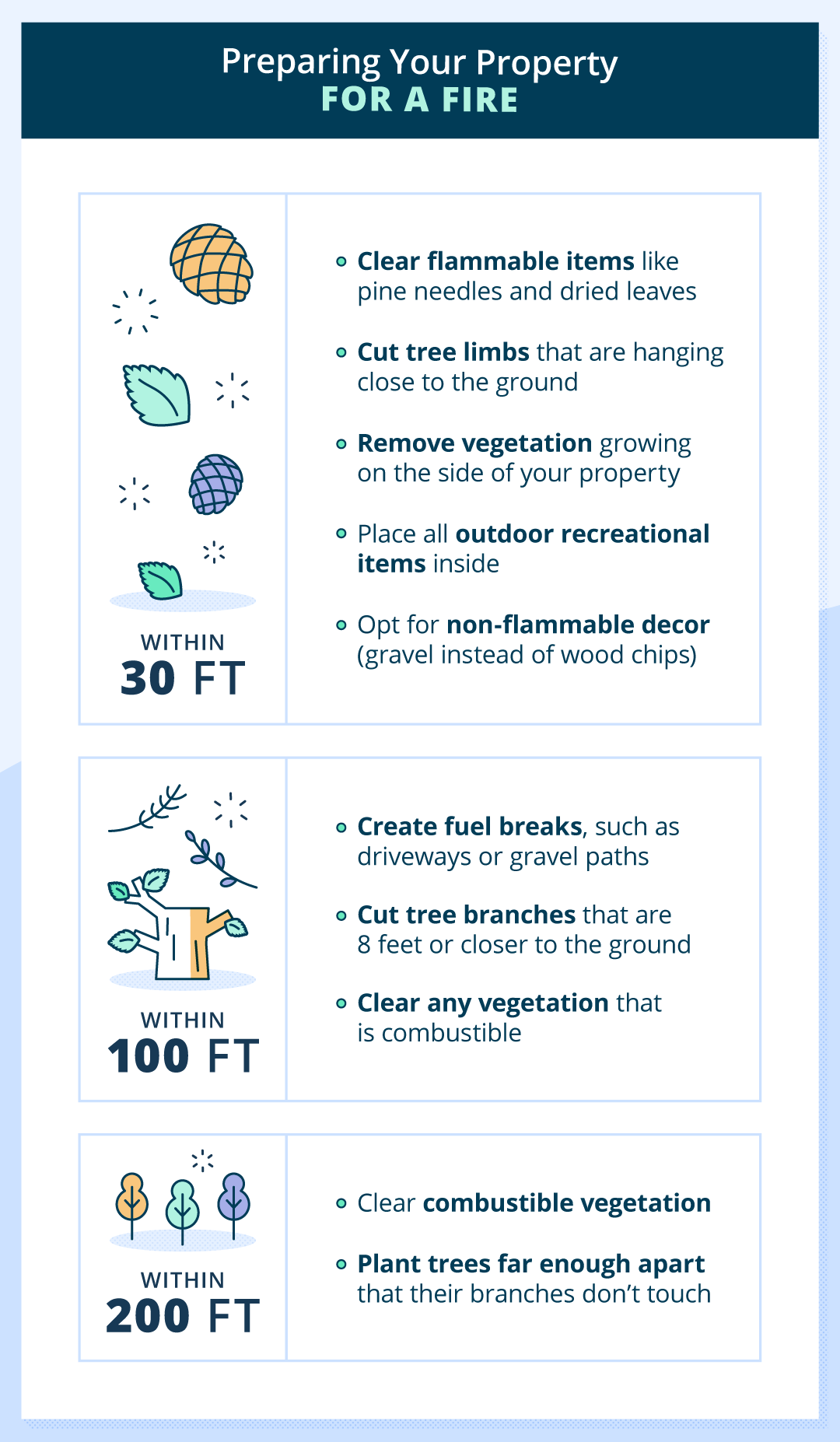
If a wildfire is spreading in an area where your rental properties are located, you should:
- Remove flammables: Instruct tenants to move flammable items in the house away from windows, including curtains and shades. Also, clear 30 feet of vegetation around your property and plant fire-resistant shrubs like hardwoods, maples, and roses if you have time.
- Shut off the gas: Have the gas shut off at the meter to the property.
- Smoke detectors: Make sure smoke detectors are installed and working properly.
- Check the windows: Ensure windows are easy to open and that screens can be removed quickly.
- Have an exit plan: Provide tenants with a fire extinguisher and proper fire evacuation routes along with an escape ladder if applicable. Installing exit ramps and widening doorways should also be considered if accessibility is an issue.
- Update fixtures: Remove all old or damaged appliance cords as these are fire hazards, and install mesh screens under flooring and in doorways.
Wildfire Safety Tips
In the event of an unexpected fire, here are some safety tips that both landlords and renters should follow to ensure maximum safety:
- Stay on top of news from local area radio and TV.
- If a wildfire starts, be prepared to evacuate immediately. Use a map to track current fires and locate open shelters.
- Have an emergency supply kit on hand. Make sure all items are restocked if you’re close to running out.
Winter Storms
As cold weather approaches, precipitation in severely low temperatures can cause significant amounts of snow and sleet. These natural disasters occur when winds are 35 MPH or higher, last for three hours or longer, and have the potential to cause damage to properties, such as burst pipes from frozen water or collapsed roofs from accumulated snow. In 2021, winter storms in the U.S. caused a whopping $15 billion in insured losses.
Freezing rain, ice, and snowfall tend to strike from early autumn to late spring. These winter storms or blizzards are the most common in the upper Midwest and the Great Plains but can strike in most areas of the country (with the exception of the Gulf Coast and California coast).
Regions most affected:
- North Dakota
- South Dakota
- Western Minnesota
How to Prepare
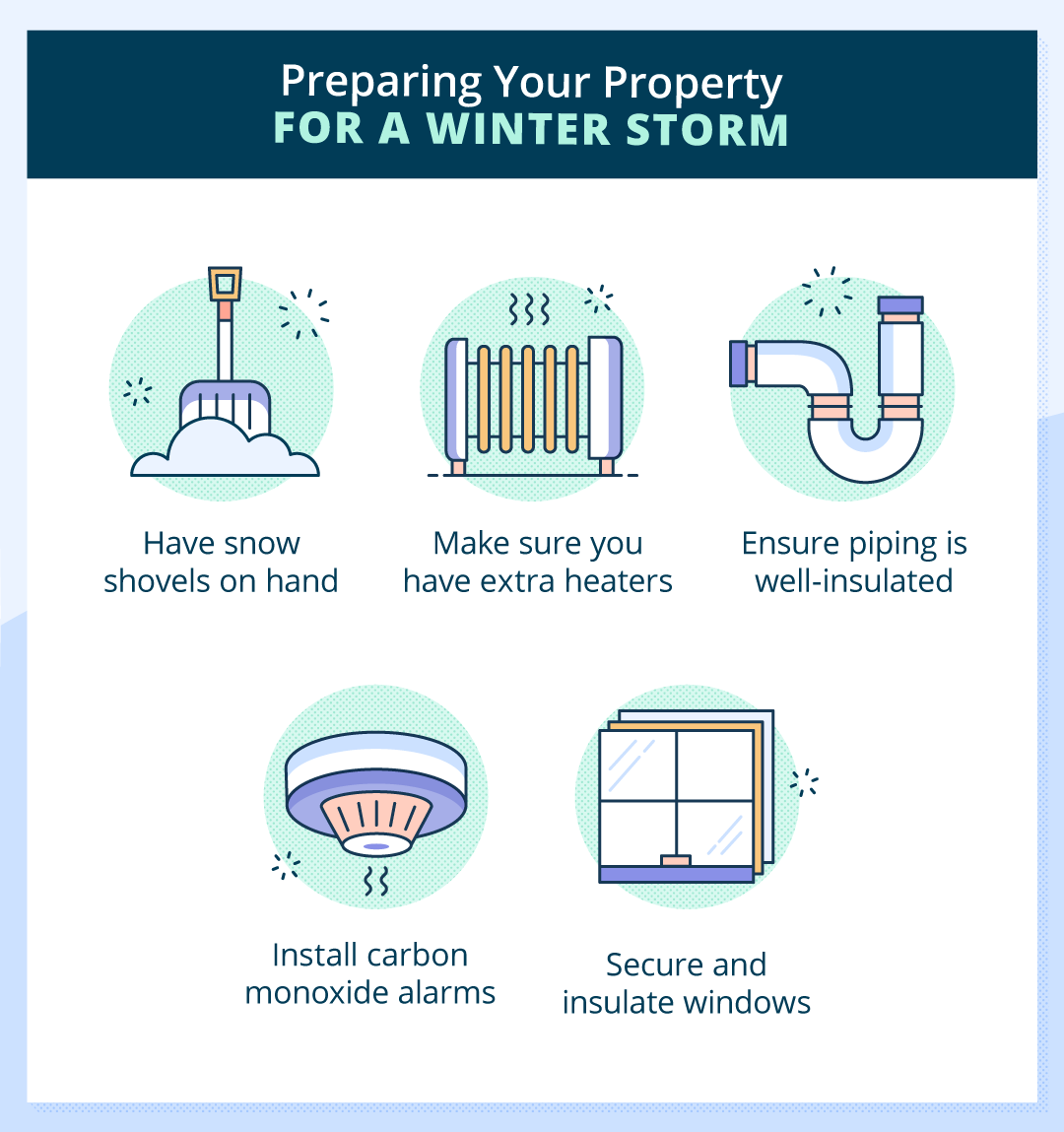
Winter storms and blizzards can damage your property if you’re not prepared properly. Here are some helpful ways to prepare your property before a winter storm approaches as a landlord:
- Snow shovels: Make sure your property has snow shovels available for you and your tenants.
- Heating essentials: Ensure your tenants have a heat source, whether it be a wood-burning stove or extra wood for a fireplace.
- Check the utilities: Confirm the pipes on your property are well-insulated and protected against the cold. To add more insulation, wrap the pipes in newspaper or plastic.
- Install carbon monoxide alarms: Carbon monoxide fatalities tend to increase during cold months.
- Leave the faucets running: Tell tenants to leave the faucets slightly running or to use them often to ensure stagnant water doesn’t freeze.
- Secure windows: Place plastic over windows or install storm windows.
Winter Storm Safety Tips
Be sure you know the difference between winter storm watches and warnings. A winter storm watch means a winter storm is possible in your area. A winter storm warning means a winter storm is occurring or is about to occur in your area. In the event of a winter storm, there are precautions landlords and tenants should consider to stay safe:
- Have a disaster kit complete with a first aid kit, canned food, bottled water, blankets, warm clothing, and a battery-operated radio to hear the latest instructions from officials.
- During the storm, stay indoors and wear warm clothing.
- Stay hydrated and eat — this helps the body easily produce its own heat.
- Keep dry and change out of any wet clothing to avoid hypothermia and frostbite.
- If you need to drive for any reason, alert someone of your destination in case you get stuck in the snow.
- If your car gets stuck in the snow, stay inside the vehicle and wait for help if you’re far away from the main road.
- Avoid overexertion. One of the leading causes of death during winter storms is heart attacks from shoveling snow. Cold weather puts added strain on the heart, making it more vulnerable.
Looking to prepare your rental property for winter? into our detailed blog post and accompanying video guide on essential winterization techniques tailored for landlords.
Landslides
Landslides can occur with little to no warning at all; all it takes is a significant amount of materials, such as rock, mud, and other debris, to begin moving down a slope. These natural disasters usually follow fires, earthquakes, or heavy storms. Landslides can travel at a rate of up to 35 MPH, destroying everything in their path. Every year, landslides in the United States cause between $2-$4 billion in damages.
Luckily, scientists have developed slope stability models to predict and analyze local risk for landslides. Regions along the Appalachian Mountains, Rocky Mountains, and Pacific Coastal Ranges are most likely to be affected by this type of disaster.
Regions most affected:
- California
- Oregon
- Washington
- Alaska
- Hawaii
How to Prepare
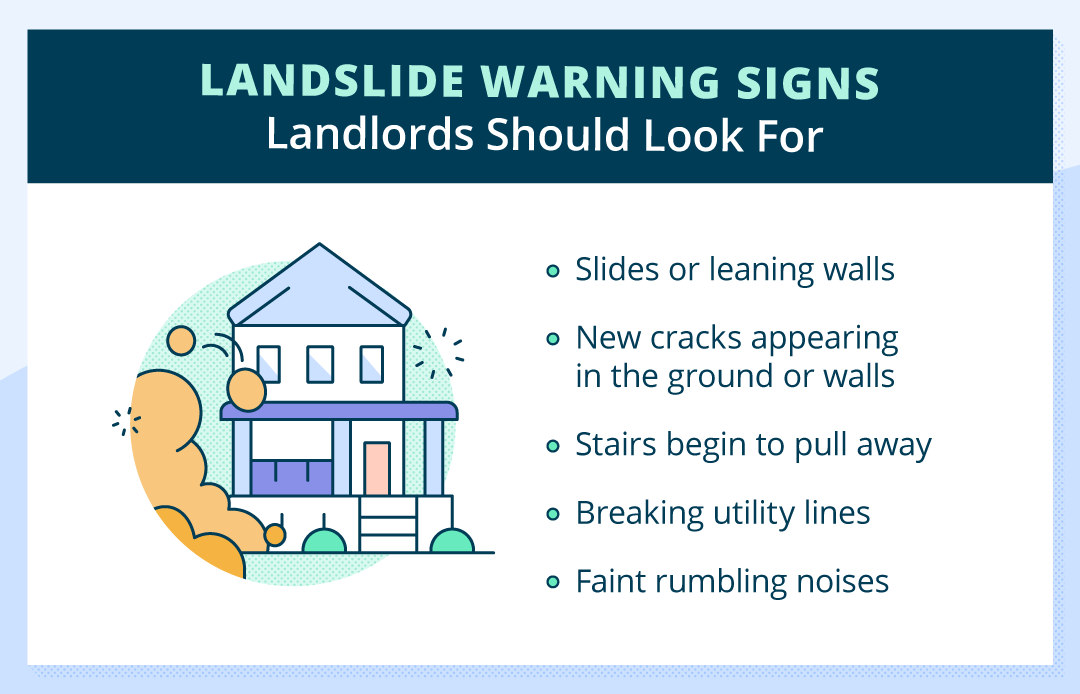
If your property is located in an area where landslides are common, take these preventative measures into account to minimize damage to your property:
- Assess your property: Get a ground assessment of your property. This helps determine if there are any potential risks or liabilities.
- Gather information: Contact local officials and geologists for an analysis of your property, information on landslides in your area, and information on collective measures you can take.
- Get insured: If your property is located in an at-risk location, talk to your agent and consider getting insurance.
- Secure your property: Build retaining walls and plant ground cover on slopes. Also, build channels to direct the flow of landslide debris around buildings. Make sure you direct these channels away from neighboring properties to avoid damage liability.
- Check pipes: Be sure to install pipe fittings that are flexible to help resist any potential breakage.
- Look for warning signs: Check for warning signs that a landslide may occur, such as slides or leaning walls in your property, new cracks appearing on the walls or ground, stairs beginning to pull away, breaking utility lines, or faint rumbling sounds (this is the sound of debris moving).
Landslide Safety Tips
Although landslides occur with little to no warning, here are some tips on what to do if you or your tenants experience a landslide:
- Stay alert. Landslides can be caused by short bursts of intense rain in prone areas, so pay attention to the weather forecast.
- Listen for unusual sounds, such as boulders knocking together or trees cracking — this usually indicates moving debris.
- Move to the second story of your home if applicable to stay out of the path of moving debris.
- Look for a change in water flow or change from clear to muddy water if you live near a channel or stream. These shifts can indicate landslide activity that is occurring upstream.
- Be careful when driving. If you are in the process of evacuating the property, stay alert when driving and avoid driving over flooded areas. Watch out for collapsed pavement, fallen rocks, mud, or other debris.
Earthquakes
An earthquake is a rapid shaking of the ground suddenly caused by the shifting of plates of rock beneath the surface of the earth. These natural disasters can kick off tsunamis, fires, avalanches, and landslides. While they can happen anywhere without warning, there are certain areas that are more likely to be affected by earthquakes, such as the West Coast.
Regions most affected:
- Alaska
- California
- Nevada
- Hawaii
- Washington
How to Prepare
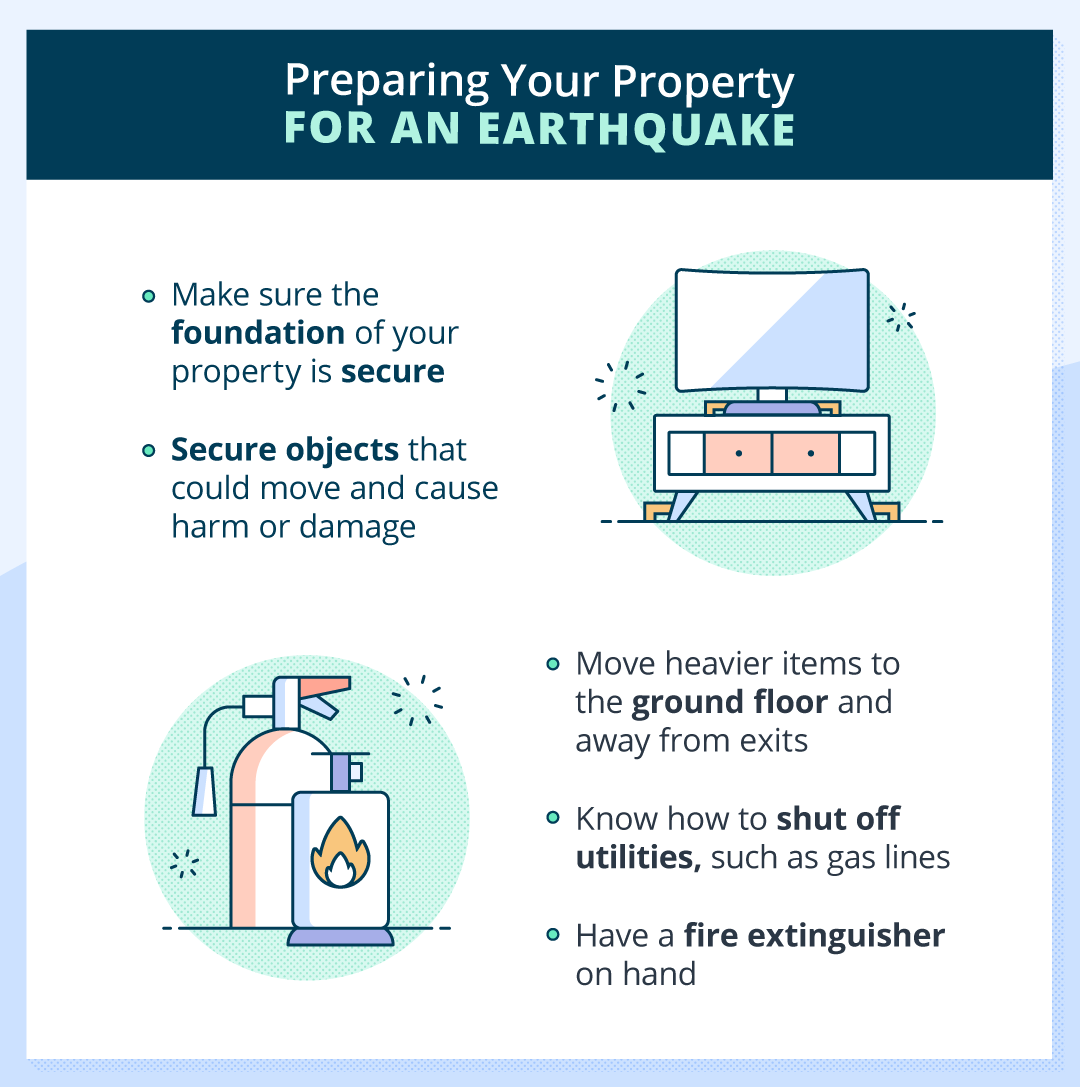
If you’re located in an area that is prone to earthquakes, follow these tips to secure your property:
- Identify weaknesses: Make it a point to be aware of and fix any weaknesses in your property that could cause it to be more vulnerable. Weak crawl space walls, unreinforced foundations, and unanchored structures are examples of structural vulnerability.
- Secure objects: Tell your tenants to secure objects that could fall in the property, such as appliances and furniture, or consider relocating them to safer areas that are away from beds, windows, and any exits that could be blocked.
- Move heavier objects: Heavier objects cause the most damage when things fall during an earthquake, so have your renters move these objects to the ground.
- Practice shutting off the utilities: In the event of an earthquake, it’s safest to shut off the water, gas, and power lines in your property. Ensure you and your tenants are able to cut off the power to the circuit box.
- Equip your property: Sometimes earthquakes can cause fires, so double-check that your property has a fire extinguisher that is in working order.
Earthquake Safety Tips
To stay safe during an earthquake, follow the tips below:
- If you’re in a vehicle: Pull over, stop, and set your parking brake.
- If you’re in bed: Cover your neck and head with a pillow and lay face down.
- If you’re inside: Do not run outside — stay in place. Avoid doorways and windows, as these are more susceptible to collapsing.
- If you’re outdoors: Stay away from buildings that may topple over.
- Follow the Drop, Cover, Hold On method: Wherever possible, drop to the floor and grab onto something sturdy, like a desk or table. Make sure to cover your head and neck.
Handling Pets During an Evacuation
If your tenants live in an area that is under evacuation during a natural disaster, check in with them and urge them to obey evacuation orders. Remind tenants with pets that they should bring along all animals during an evacuation. The Pets Evacuation and Transportation Standards Act (PETS) requires accommodation for pets during an evacuation. Remind tenants that due to this act, their pets will be allowed in designated shelters and on evacuation transit.
What to Do After a Natural Disaster
After a natural disaster has passed through the area your rental properties are located in, it is time to start assessing the damages and taking the next steps. Remember, these damages will differ from normal wear and tear. Post-disaster, you will need to make decisions about your property, insurance claims, and what to do with tenants who have evacuated, are late on rent, or return to uninhabitable homes.
When the Property is Uninhabitable
If a natural disaster damaged your rental property to the point that it is deemed uninhabitable, most states will follow similar regulations as outlined in the Uniform Landlord Tenant Act (URLTA). This act states that in the case of disasters, “If the dwelling unit or premises are damaged or destroyed by fire or casualty to an extent that enjoyment of the dwelling unit is substantially impaired, the tenant may:
- Immediately vacate the premises and notify the landlord in writing within [14] days thereafter of his intention to terminate the rental agreement, in which case the rental agreement terminates as of the date of vacating
OR
- If continued occupancy is lawful, vacate any part of the dwelling unit rendered unusable by the fire or casualty, in which case the tenant’s liability for rent is reduced in proportion to the diminution in the fair rental value of the dwelling unit.”
Essentially, this act states the lease is voided when the property becomes uninhabitable in the states that have adopted this act or similar laws. Some states used this act as a jumping-off point and created slightly different versions of these laws.
Be sure to check in with your specific state’s regulations for more details. Because laws and regulations can vary greatly from state to state, it’s best to consult a local attorney to determine the best course of action in the case of an uninhabitable home.
When the Property is Habitable
If your rental properties are still habitable, you may still face unique circumstances with your tenants. Lost time from work due to evacuations and other distress may leave tenants who live paycheck to paycheck struggling to pay their rent. Here are some of the responsibilities you face as a landlord in these situations:
- If the home is still habitable, the lease is still binding: However, it is important to keep in mind that natural disasters can be extremely difficult on those with little to no savings. In fact, according to Harvard’s Joint Center for Housing Studies, renters have median cash savings of $630, which means a natural disaster can wipe out their savings. Depending on whether or not they carry renters insurance, they may be left with very little to their name.
- If you have tenants who have been in good standing: Treat them fairly and according to the circumstances they’re facing. While you’re still running a business and need to meet your costs as a landlord, it is also important to remember that natural disasters can burden those with fewer means.
- If you have tenants who are struggling to keep up: Direct them to FEMA’s website where they can apply for assistance. FEMA provides individual disaster assistance to those affected by natural disasters and should help renters with costs associated with hurricanes, wildfires, and other national emergencies.
File an Insurance Claim
After a natural disaster, you’ll want to begin the process of filing insurance claims. How much assistance you will receive through your insurance will vary greatly depending on your landlord insurance policy. It’s best to require tenants to carry their own renters insurance, as their policy will not only protect their belongings and losses, but in some cases, it can also help you cover deductibles.
Unfortunately, the process for filing claims can be extremely slow in the case of major disasters. With so many claims flooding the system, patience will be key. The better documentation you keep upfront, the better chance you’ll have of receiving fair compensation for damages.
Helpful Resources
No matter what natural disaster you find yourself faced with, there are plenty of government and non-profit resources that can help you if you’re in need. Here is a helpful list of resources for both landlords and renters:
Hurricane Resources
- National Hurricane Center
- FEMA Flood Map Service Center
- American Red Cross Hurricane Safety
- Food and Water Safety During Power Outages
Wildfire Resources
Winter Storm Resources
- Stay Safe During and After a Winter Storm
- Winter Storm Preparedness
- Winter Safety Social Media Toolkit
- National Weather Service
- Osha’s Winter Storm Guidance
Landslide Resources
- Red Cross Landslide Safety
- USGS Landslide Preparedness
- U.S. Geological Survey Landslide Program
- Landslide Disaster Information
- Landslides and Mudslides Facts
Earthquake Resources
- Red Cross Earthquake Safety
- Earthquake Preparedness: How to Stay Safe
- Earthquake Country Alliance: Resources for People With Disabilities
- American Red Cross
- Earthquake Safety at Home
Disaster Supply Checklist
Additionally, you can help your tenants prepare for a natural disaster with this supply kit checklist that includes everything they’ll need, from important documents to first aid items.

A natural disaster can leave both landlords and tenants wondering what comes next. As a landlord, ensuring your property is well-equipped to withstand these natural disasters will make rental applicants more comfortable. Plus, these tips and resources will help guide you after a natural disaster strikes.
Remember, always consult an attorney when in doubt and try to work with your tenants as much as possible during trying times. Visit our tenant screening services to help find the perfect renters for your property.
DISCLAIMER: TurboTenant, Inc. does not provide legal advice. This material has been prepared for informational purposes only. All users are advised to check all applicable local, state and federal laws and consult legal counsel should questions arise.
